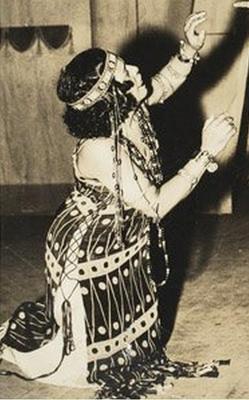La Julia Rhea facts for kids
Quick facts for kids
La Julia Elizabeth Rhea
|
|
|---|---|

La Julia Rhea performing Aida with the National Negro Opera Company in 1943.
|
|
| Born | March 16, 1898 Louisville, Kentucky, U.S.
|
| Died | July 5, 1992 (aged 94) Blue Island, Illinois, U.S.
|
| Occupation | Opera singer |
| Years active | 1903-1949 |
| Spouse(s) | Henry J. Rhea |
| Children | Henry J. Rhea, Jr. Robert Rhea |
La Julia Rhea (born March 16, 1898 – died July 5, 1992) was an amazing American opera singer. She was a soprano, which means she sang the highest notes in opera. She broke barriers for Black performers in the world of opera.
Discovering La Julia Rhea's Life
Early Life and Musical Start
La Julia Rhea grew up in Louisville, Kentucky. She started singing publicly at a young age. She was part of the children's choir at the Hill Street Baptist Church.
In 1925, she moved to Chicago. There, she joined the R. Nathaniel Dett Club of Music and Allied Arts. She also studied at the Chicago Musical College and graduated from there.
Her first professional performance was in 1929 at Chicago's Kimball Hall. For over 20 years, she performed concerts all over the United States. During this time, she also learned many different opera roles.
Breaking Barriers in Opera
La Julia Rhea was a very talented singer. In 1927, she sang a song called "O Don Fatale" from Verdi's Don Carlos. A newspaper writer named Sylvester Russell praised her performance. He said she had a "wonderful range and power." He also called her one of the "greatest human voices."
In the early 1930s, Rhea toured the country. She performed with famous singer Ethel Waters in a show called Rhapsody in Black. She was also a main singer for the Cecil Mack Choir for a while.
It was very hard for Black performers to become widely known back then. But La Julia Rhea's teacher, Romano Romani, introduced her to the Metropolitan Opera. In 1934, she became the first Black person to get an audition there. She was highly praised for her singing. However, the Met did not hire a Black star until 1955, when Marian Anderson performed.
On May 13, 1935, Rhea sang a song from H.M.S. Pinafore. She won over 6,000 votes from the audience! This made her the first Black winner of an audition on the Major Bowes Amateur Hour. She then toured with the group under the name Rea Parada.
Despite her experience at the Met, Rhea made history. On December 27, 1937, she became the first Black performer to star in a main role for a major opera company. She played the lead role of Aida in Verdi's Aida with the Chicago Civic Opera Company. William Franklin sang the role of Amonasro.
A drama critic for the Chicago Tribune named Cecil Smith wrote about the performance. He said it was a "musical event without parallel." He noted that both Rhea and Franklin were "warmly applauded." The beautiful costume Rhea wore for Aida was a gift. It came from her teacher, the famous opera star Rosa Raisa. Rosa Raisa had worn it herself when she first performed Aida in 1914.
Both La Julia Rhea and William Franklin also performed with the National Negro Opera Company (NNOC). They sang in operas and operettas. In 1941, Rhea performed in Aida for the very first show of the National Negro Opera Company. This event was organized by Mary Cardwell Dawson.
In 1942, La Julia Rhea helped sell bonds during World War II. She appeared with important people like Chicago Mayor Edward J. Kelly and singer Marian Anderson. This event was called the Chicago Musical War Rally.
Later Life and Teaching
After she stopped performing publicly, La Julia Rhea continued to be involved in opera. She gave private singing lessons to young people who dreamed of becoming opera stars. She taught them at her home in Blue Island.
She was known for her fun annual lawn parties. Musicians from all over the country would come to these parties. She also sometimes appeared on public radio.

